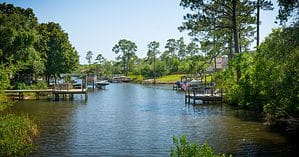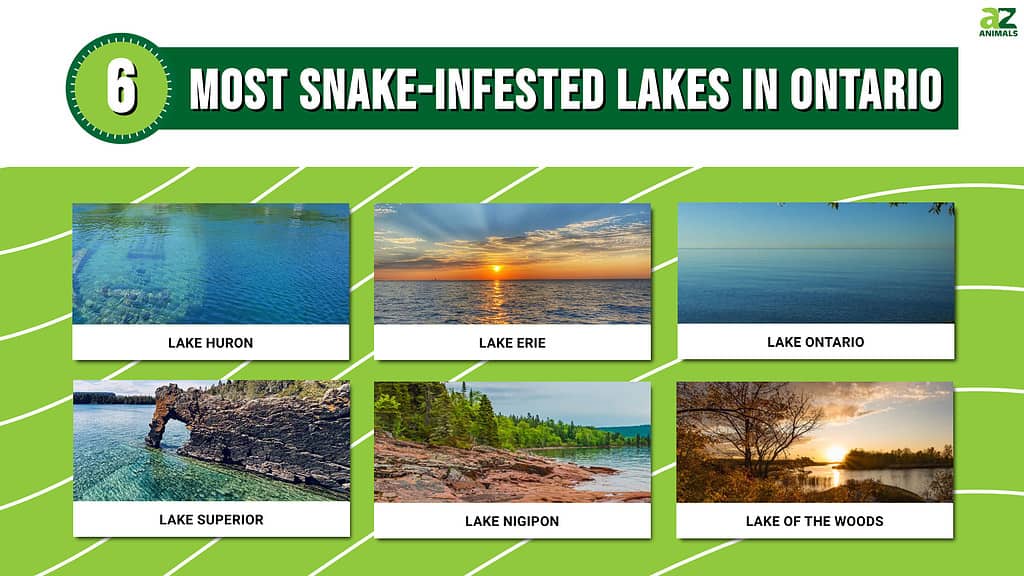
Ontario, Canada, is home to 17 species of snakes. Only three of these are water snakes, but there are a variety of semi-aquatic snakes that can be found in and around the many rivers, streams, and lakes.
Ontario has an abundance of lakes. Over 250,000 to be exact. In fact, one-fifth of the world’s freshwater is in Ontario. Four of the five Great Lakes are within the borders of Ontario, and it’s the only province in Canada that touches the Great Lakes. While Lake Michigan is the only Great Lake that doesn’t border Ontario.
Swimming around in all of that freshwater is a variety of water snakes and semi-aquatic snakes. Although not nearly as snake-infested as lakes in warmer climates, like Florida or Texas, it is possible to spot a snake slithering by in a lake in Ontario.
What are the 6 most snake-infested lakes in Ontario? Read on to find out. But first, let’s take a look at some interesting facts about snakes found in Ontario.
What Is the Most Common Snake in Ontario?
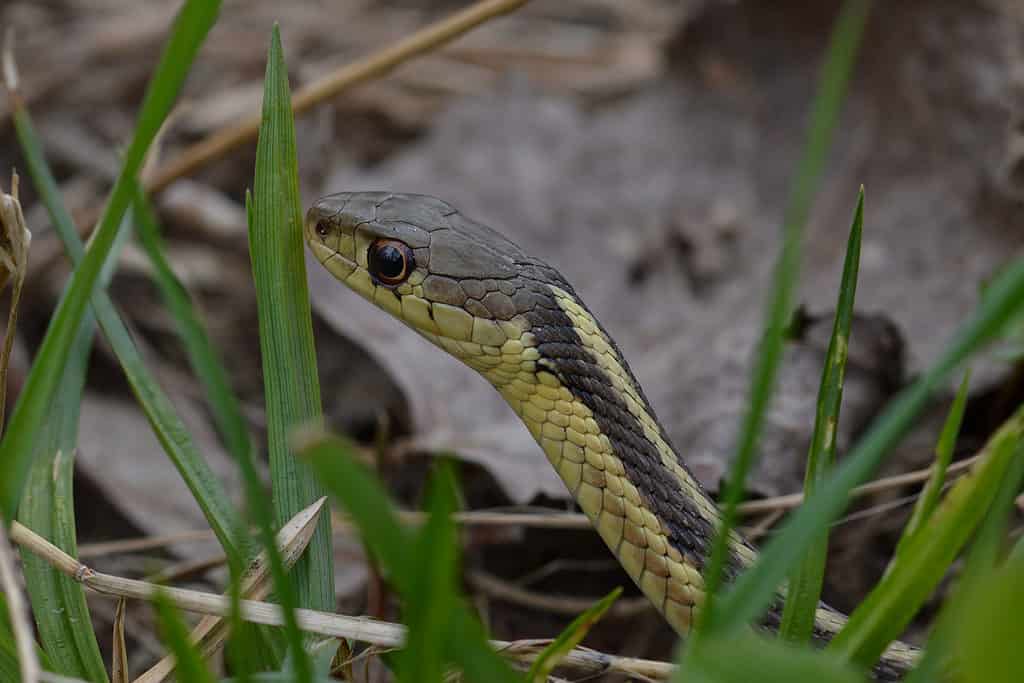
The eastern garter snake is abundant throughout Ontario and has the ability to adapt well to human-modified landscapes.
©Ryan Hodnett, CC BY-SA 4.0, via Wikimedia Commons – License
The eastern garter snake is a subspecies of the common garter snake. They have greenish, brown, or black bodies, and distinct yellow or white stripe. The eastern garter snake is abundant in Ontario and it’s the snake people are most likely to spot.
Eastern garter snakes are strong swimmers. Their habitats are near freshwater sources like lakes, ponds, and streams. It’s a non-venomous snake and tends to be relatively harmless. However, if you try to pick one up, it will defend itself by biting. Although not venomous, the bite may cause minor swelling or itching.
Are There Any Venomous Snakes in Ontario?
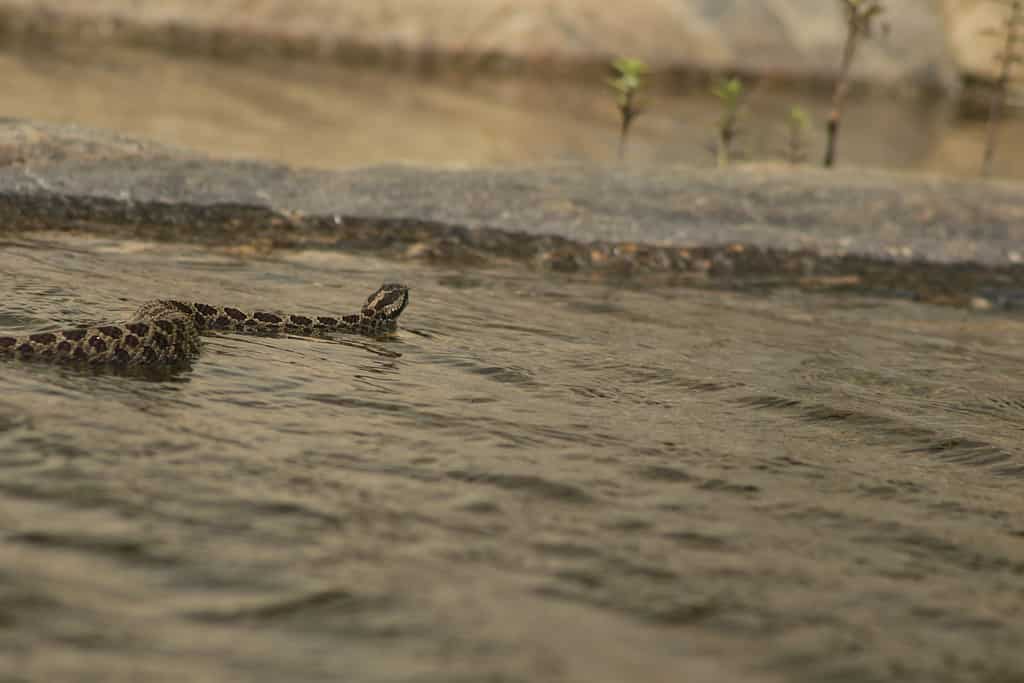
The Eastern Massasauga
rattlesnake
is the only venomous snake in Ontario. They are shy and avoid humans whenever possible.
©mynewturtle/Shutterstock.com
Yes, but only one. The Eastern Massasauga Rattlesnake is a threatened species and the only venomous snake in Ontario. Although not a water snake, the Massasauga is a good swimmer. The Massasauga is very shy and tries to get away from people. However, it will attack if threatened. A rare species to spot, the Massasauga has been reported on the eastern side of Georgian Bay and the Bruce Peninsula (Lake Huron), and in the Wainfleet Bog on the northeast shores of Lake Erie.
And now, let’s take a look at some of Ontario’s most snake-infested lakes.
1: Lake Huron
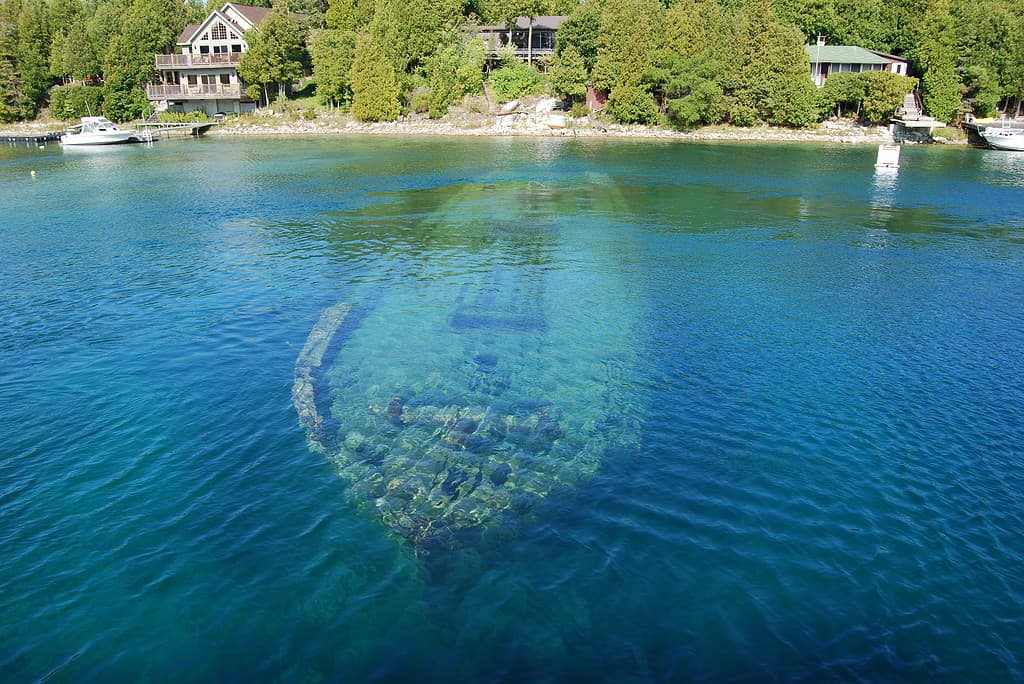
A sunken ship is visible from underwater off the Bruce Peninsula in Lake Huron.
©Kibrok Photography/Shutterstock.com
Lake Huron boasts the longest shoreline of all the Great Lakes (3,827 miles) and is home to about 30,000 islands. The second largest of the Great Lakes, Lake Huron has gorgeous sand dunes, soft sandy beaches, picturesque lighthouses, sparkling turquoise water, wetlands, forests, and many coves, channels, and bays.
An interesting fact about Lake Huron is the vast amount of shipwrecks that have occurred in the waters. In fact, there have been over a thousand shipwrecks there, and many ruined vessels are still sitting somewhere on the bottom of the lake. The area of Thunder Bay, on the Michigan side of Lake Huron, is called “shipwreck alley.” Almost one hundred shipwrecks have been found in a 4,300-square-mile area in and around Thunder Bay.
Lake Huron is also home to diverse wildlife, including reptiles, and is one of the most snake-infested lakes in Ontario. The rare Massasauga lives in some areas of Lake Huron. The eastern garter snake is a common site around the shore. The endangered eastern fox snake, one of Ontario’s largest snakes, lives in marshes and shorelines near the Georgian Bay. Other snakes you might spot in and around Lake Huron include the common water snake, common ribbon snake, and queen snake.
2: Lake Erie
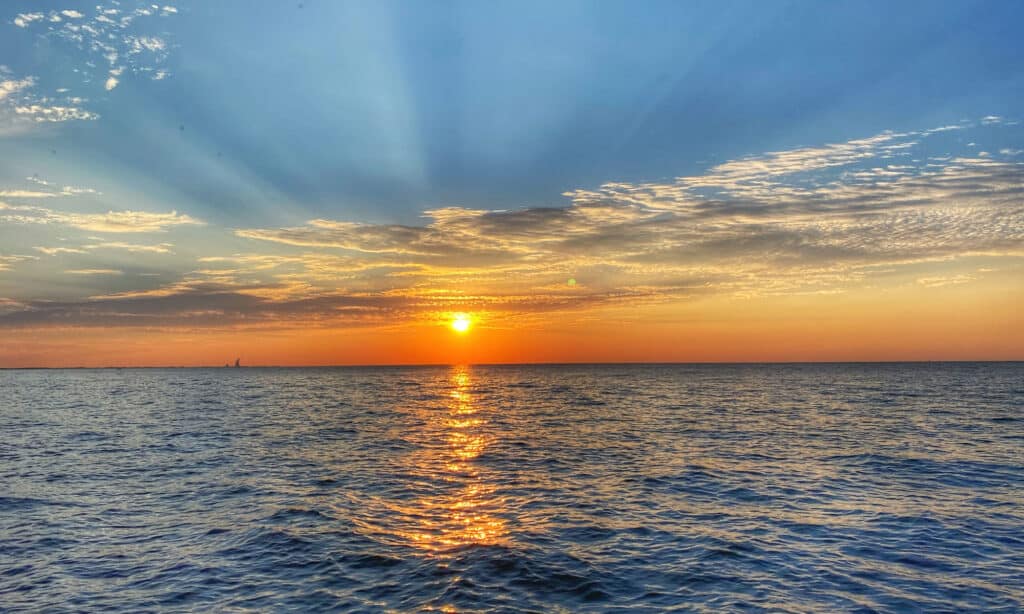
Lake Erie is one of the smallest Great Lakes, but it provides drinking water to over 11 million people.
©iStock.com/becky johnson
The fourth largest lake of the Great Lakes when you go by surface area, Lake Erie is one of the smaller of the Great Lakes. Lake Erie borders Michigan, New York, Ohio, and Ontario. An important lake to both Canada and the United States, Lake Erie provides drinking water to over 11 million people and as its water empties through the Niagara River, it provides hydroelectric power to millions of people through Niagra Falls.
It’s more shallow than the other Great Lakes, and its waters are warmer, making it home to a diverse number of snake species. The venomous Massasauga resides in bogs and marshy areas along the lake. The Lake Erie watersnake is a subspecies of northern water snake. Its habitat is on a few of Lake Erie’s many islands.
Other snakes you may see in and around Lake Erie include the northern water snake, eastern foxsnake, gray ratsnake, eastern garter snake, and the common water snake.
3: Lake Ontario
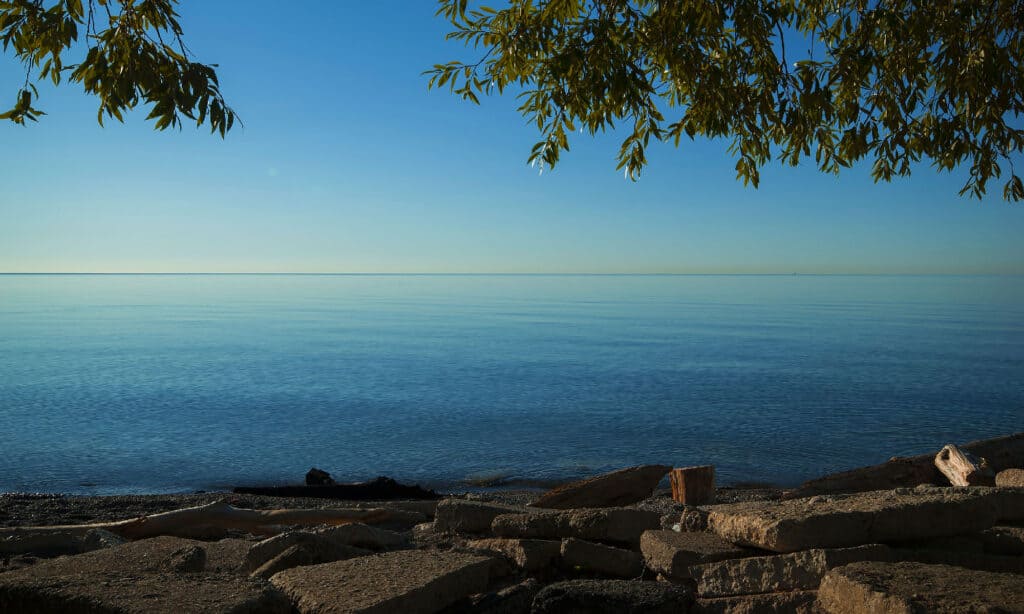
All the water from the Great Lakes flows through Lake Ontario on the way to the Atlantic Ocean.
©Michael J. Eves/Shutterstock.com
The smallest of the Great Lakes by surface area, and the most easterly, Lake Ontario is bounded on the north by Ontario, and to the south by New York. It’s located between Lake Erie and the St. Lawrence River and is close to the Atlantic Ocean. Every bit of water from the Great Lakes flows through Lake Ontario and out into the Atlantic Ocean.
Lake Ontario supports a variety of habitats including forests, wetlands, barrier beaches, rocky cliffs, and sand dunes. The shoreline includes 712 miles of mainly narrow sand beaches and striking bluffs. The Scarborough Bluffs in Toronto is a nine-mile stretch of stunning cliffs with scenic views of the lake. The bluffs, formed by wind and water erosion from the lake, are a popular hiking spot.
Main Duck Island is a small island in the eastern part of Lake Ontario. This tiny island within the Thousand Islands National Park is known for its large population of northern water snakes. One of the largest snakes found in Ontario, northern water snakes can grow from 24 to 42 inches long. Other snakes found in and around Lake Ontario include the eastern garter snake and gray ratsnake.
4: Lake Superior
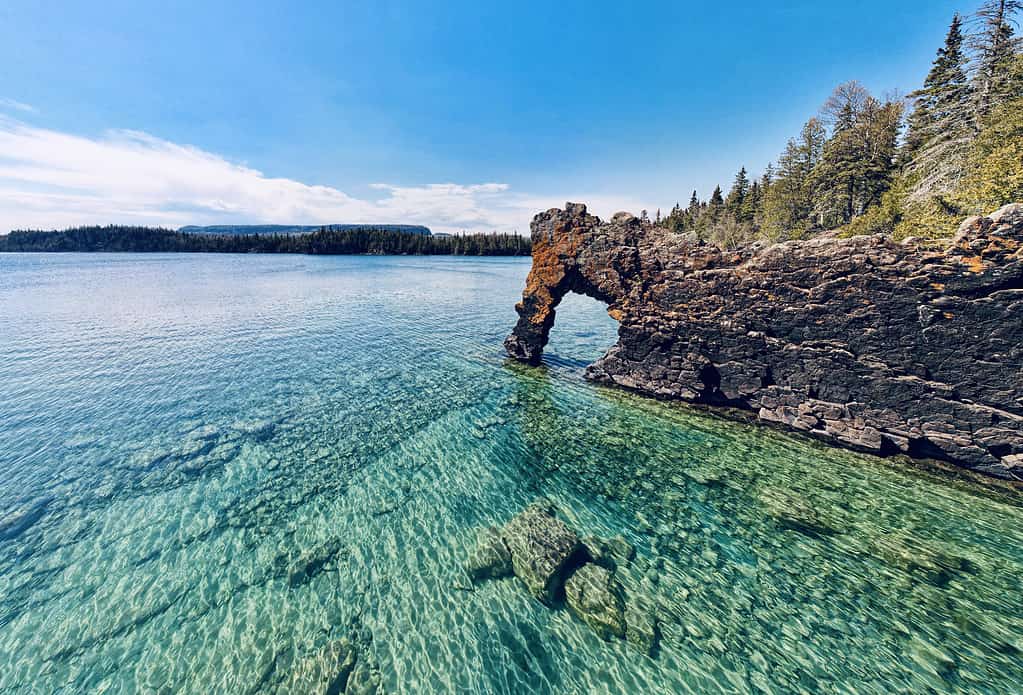
A rock formation called the Sea
Lion
, located in the Sleeping Giant Provincial Park in Ontario was formed by waves cutting an arched tunnel into sedimentary rock.
©Wirestock Creators/Shutterstock.com
Lake Superior, the most northwestern Great Lake, is the largest freshwater lake in the world by surface area and the third largest in the world by volume. It’s the deepest of the Great Lakes with a maximum depth is 1,332 feet. Ontario, Minnesota, Michigan, and Wisconsin all border the lake.
Lake Superior has pristine and sparsely populated shores with heavy forests surrounding it. The coastline has deep bays, high cliffs, and natural harbors. It’s the coldest Great Lake, and also the least affected by invasive species and habitat destruction. Its water stays chilly year-round. In summer the water temperature only gets up to around 40 degrees Fahrenheit.
Although the water in Lake Superior stays cool all year, you can still find snakes in and around the water. Snakes you may run into in Lake Superior include the northern water snake and eastern garter snake.
5: Lake Nigipon
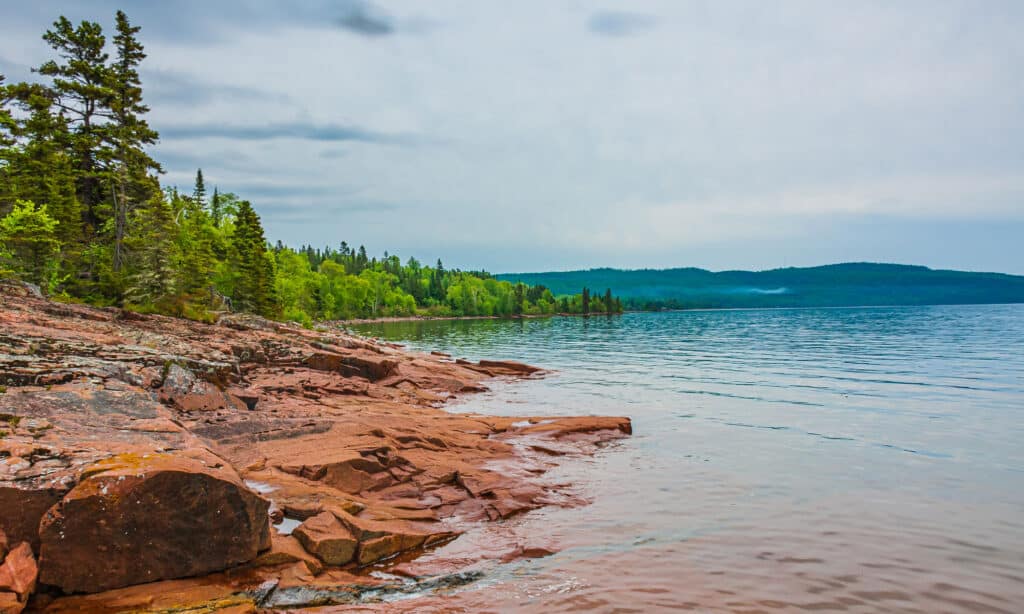
Eastern garter snakes are abundant around Lake Nigipon, the largest lake located entirely within Ontario.
©Gus Garcia/Shutterstock.com
Lake Nigipon is the largest lake that is located entirely within Ontario. The lake is in the Great Lakes drainage basin, and its waters drain into the Nipigon River, then the Nipigon Bay, and finally into Lake Superior. The Nigipon River is the largest tributary of Lake Superior. Like Lake Superior, Lake Nigipon’s waters are cold and pristine. The maximum depth is 540 feet, and it’s home to many small islands.
Sometimes called the sixth Great Lake, it’s known for its gorgeous landscapes with steep cliffs, and unique green-black sand beaches. The sand gets its distinct coloring from minute particles of a dark green mineral known as pyroxene.
The eastern garter snake, common across Ontario, can be found in and around Lake Nipigon.
6: Lake of the Woods
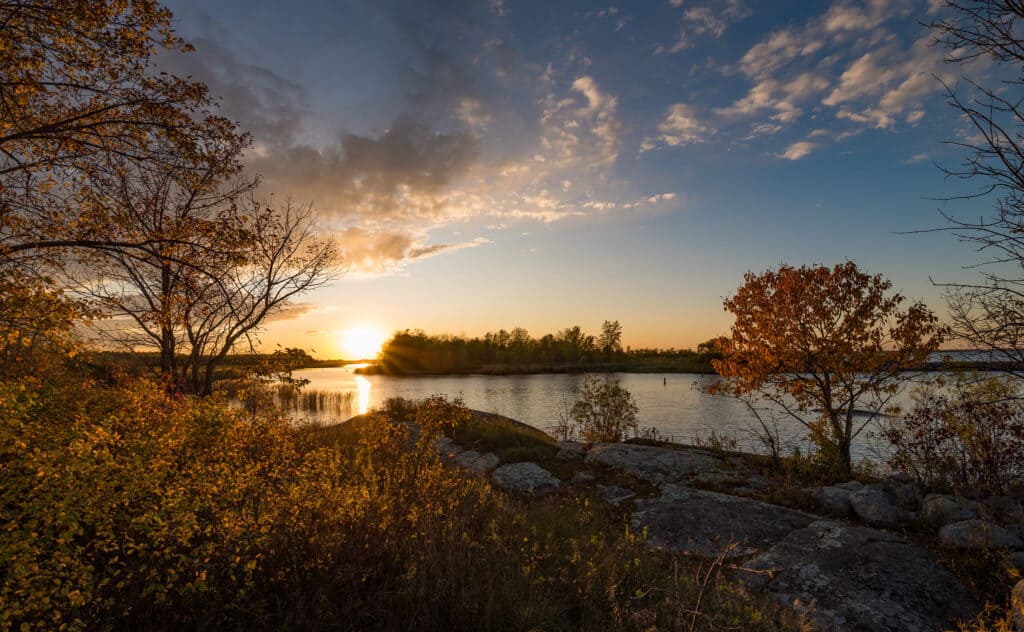
Lake of the Woods contains over 14,500 islands.
©Tony Webster / CC BY-SA 2.0 – License
Lake of the Woods is in the provinces of Ontario, Manitoba, and the state of Minnesota. Like Lake Nipigon, it’s sometimes referred to as the sixth Great Lake. Astoundingly, this lake contains over 14,500 islands. The islands are nesting sites for several hundred pairs of bald eagles. They also provide habitat for the piping plover, an endangered shorebird known for spending its summers along the coasts of the Great Lakes.
The lake is a famous spot for fishing muskellunge (commonly known as muskie), the largest member of the pike family. Other fish abundantly found in the lake include trout, bass, lake whitefish, and walleye. As for snakes, the eastern garter snake is abundant in the area and may be found swimming in the lake.
Summary of the 6 Most Snake-Infested Lakes in Ontario
| Lakes | Snakes |
|---|---|
| Lake Huron | Eastern Massasauga Rattlesnake, Eastern Garter Snake, Eastern Foxsnake, Common Water Snake, Common Ribbon Snake, Queen Snake |
| Lake Erie | Eastern Massasauga Rattlesnake, Lake Erie Water Snake, Northern Water Snake, Eastern Foxsnake, Gray Ratsnake, Eastern Garter Snake, Common Water Snake |
| Lake Ontario | Northern Water Snake, Eastern Garter Snake, Gray Ratsnake |
| Lake Superior | Northern Water Snake, Eastern Garter Snake |
| Lake Nigipon | Eastern Garter Snake |
| Lake of the Woods | Eastern Garter Snake |
The photo featured at the top of this post is © iStock.com/flyzone
Thank you for reading! Have some feedback for us? Contact the AZ Animals editorial team.






